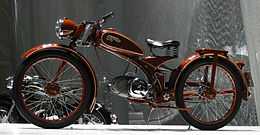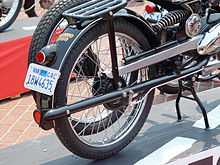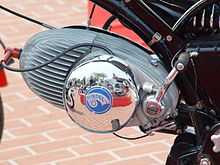Imme R100
 Imme R100 viewed from the left | |
| Manufacturer | Riedel AG |
|---|---|
| Also called |
Riedel R100 Riedel Imme |
| Production | 1948-1950 |
| Assembly | Immenstadt, West Germany |
| Successor | ZMG R175 |
| Class | Standard |
| Engine | 99 cc (6.0 cu in) piston-ported two-stroke single-cylinder engine |
| Bore / stroke | 52 mm × 47 mm (2.0 in × 1.9 in)[1] |
| Power | 4.5 PS (3.3 kW; 4.4 hp) at 5,800 rpm |
| Ignition type | kick start |
| Transmission | Three forward speeds with no neutral position |
| Frame type | Tubular steel spine frame, with engine mounted on the swingarm |
| Suspension |
Front: Single-sided girder fork with coil spring an friction damper Rear: Single-sided swingarm with coil spring an friction damper |
| Brakes | Drum brakes, front and rear |
| Tyres | 2.50 x 19, front & rear[2] |
The Imme R100 was a lightweight motorcycle made by Riedel AG from 1948 to 1951. It is noted for its simple and innovative design with many advanced features. With low cost and technical innovation, the R100 sold well, but reliability problems and low profit margins resulted in warranty costs driving Riedel AG into bankruptcy.
The advanced specification of the Imme R100 caused it to be highly regarded. The R100 was one of the motorcycles included in "The Art of the Motorcycle" exhibition at the Solomon R. Guggenheim Museum in 1998 and is on permanent display at Barber Vintage Motorsports Museum.
Concept, design and engineering

Motorcycle engineer Norbert Riedel recognized the need for a simple and economical light motorcycle during Germany's recovery from the Second World War and began to design one. By the summer of 1947, a prototype frame had been built and tested.[2] The spine frame was made from 40 mm steel tubing,[2] as were the steering head,[3] the single-sided front fork, and the single-sided swingarm.[2] The wheels were interchangeable, and were mounted from the left on stub axles attached to the suspension on the right.[2][4]
Riedel developed the engine at the same time.[2] This was a piston-ported two-stroke single-cylinder engine of 99 cc (6.0 cu in) capacity.[2][4][5] The engine was cast in light alloy around the cylinder liner, and had an integral cylinder head.[2] The crankshaft was suspended on only one side.[2][3] The power output of the engine was 4.5 PS (3.3 kW; 4.4 hp) at 5,800 rpm,[2] which was considered a high output at the time.[6][7] Contemporary engines of comparable size typically made about 2.5 PS (1.8 kW; 2.5 hp), and 4.5 PS was expected from 125 cc engines such as those used in the DKW RT 125[8] and the later Hoffmann Vespa.[9]
The transmission had three speeds with no neutral position; a mechanism held the clutch open when the motorcycle was at idle in first gear. First gear was positioned in the middle of the shift pattern, with second gear below and third gear above.[8]
The engine and transmission were mounted together on the swingarm in front of the pivot axle at the bottom of the spine frame.[3][10] The near-horizontal engine and transmission together as a unit formed a "power egg" style which would later be used by Benelli and Motobi.[3][4][8] The tubular swingarm also served as the exhaust pipe.[3][11] Behind the pivot axle, the swingarm, the reinforced rear fender, and the supports for the rear carrier formed a triangular structure which supported the rear spring.[3] This suspension system allowed a long suspension travel and a soft spring rate. Test rides on the complete prototype began in December 1947 and showed that the combination of long travel and soft springs needed damping. Friction dampers were added.[8]
Production, marketing and demise
Norbert Riedel registered Riedel AG in 1948.[12] He moved his facilities from Muggendorf to Immenstadt and began production there in June 1948.[13] It is widely believed that the name "Imme" came from an abbreviation of this location,[4][8] and that the Imme's "bee on wheels" logo came from "Imme" being a dialect word meaning "bee".[8] However, it has also been suggested that the name came from the motorcycle itself resembling a bee,[8] or from the engine sounding like a buzzing bee.[3]

The Imme R100's light weight, relatively powerful engine, and long travel suspension made it popular in motorsport; this, along with good marketing and low pricing, led to strong sales. The management of Riedel AG expected high sales volume to offset the low profit margin.[14] A basic Imme sold for 775 Deutschmark without battery, tachometer, or centre stand.[3][14] Passenger accommodation was an optional extra, as was a spare wheel. Initially, Immes were all painted oxide red.[14]
In 1950, a better-equipped "Export" version became available for 850 Deutschmark with a battery, an electric horn, a centre stand, a speedometer, a more comfortable seat, chrome plating, pinstriping, and a choice of colours including lime green and gloss black.[14] Production of the Imme R100 had gone up to 1,000 per month and,[14] by the autumn of 1950, more than 10,000 had been sold.[3]
Imme engines were also sold to Fritz Fend, to power his Fend Flitzer invalid carriages. These replaced the Fichtel & Sachs engines used in earlier versions of the Flitzer.[15]
However, the Imme began to develop problems, especially with the single-sided crankshaft bearings and the freewheel for the kick starter.[14] Riedel corrected the problem beginning with the Model D version, which had a conventional crankshaft with two bearings.[3] However, the profit from sales was not enough to cover the warranty expenses, and, by the end of 1950, Riedel AG went bankrupt with debts of 1.25 million Deutschmark.[14]
Legacy

At the time of Riedel AGs bankruptcy, three prototypes of an Imme with a 150 cc parallel twin two-stroke engine had been made.[3] Fritz Philipps, who had been a senior executive at Riedel AG, formed Zweirad-Motoren und -Getriebe GmbH (ZMG) to supply parts and perform repairs on Imme motorcycles.[12][14] ZMG also set up to manufacture an Imme with a 175 cc straight-twin two-stroke engine, but made only 25 before they ended production.[3]
The Imme R100 is noted for its simple and innovative design.[3] Its advanced features include single-sided suspension front and rear,[4][11] interchangeable wheels front and rear with the option of a spare tyre,[16] the complete drivetrain mounted on the swingarm,[3][4][6] and the swingarm tube used as the exhaust pipe.[3][4][11] Remarking on the R100 being displayed in the Solomon R. Guggenheim Museum exhibition "The Art of the Motorcycle", Ultan Guilfoyle, curatorial adviser at the museum, said: "It's my favourite unknown bike. There are ideas there that are 40 years ahead of their time."[17] An R100 is on permanent display at the Barber Vintage Motorsports Museum.[1]
Notes
- ↑ 1.0 1.1 BARBER'S BEST/1948 Imme R100, Motorcycle Classics
- ↑ 2.0 2.1 2.2 2.3 2.4 2.5 2.6 2.7 2.8 2.9 Schwietzer 2008, p. 37.
- ↑ 3.0 3.1 3.2 3.3 3.4 3.5 3.6 3.7 3.8 3.9 3.10 3.11 3.12 3.13 3.14 Kruger 2012.
- ↑ 4.0 4.1 4.2 4.3 4.4 4.5 4.6 Wilson 1995, p. 100.
- ↑ Lischer 2003, p. 94.
- ↑ 6.0 6.1 Schwietzer 2008, pp. 37–38.
- ↑ Lischer 2003, pp. 94, 98.
- ↑ 8.0 8.1 8.2 8.3 8.4 8.5 8.6 Schwietzer 2008, p. 38.
- ↑ Vespas Glück und Ende (Vespas luck and end), Der Spiegel, 1 January 1955 pp. 9–10
- ↑ Wood 1998, pp. 25–26.
- ↑ 11.0 11.1 11.2 Wood 1998, p. 25.
- ↑ 12.0 12.1 RSGetriebe History
- ↑ Schwietzer 2008, pp. 38–39.
- ↑ 14.0 14.1 14.2 14.3 14.4 14.5 14.6 14.7 Schwietzer 2008, p. 39.
- ↑ Wagner 1973, p. 164.
- ↑ Schwietzer 2008, pp. 37, 39.
- ↑ Wood 1998, p. 26.
References
- Kruger, Ralf (2012-01-16). "Outstanding German two-strokes we shouldn't forget: Part Four, the 1950s". Ed Youngblood's MotoHistory – Ed Youngblood's News & Views – January 2012 Archive. Inverness, FL USA. 5th article down. Archived from the original on 2012-05-16. Retrieved 2012-02-26.
The reason I call the Imme outstanding is because of its unique approach to manufacturing a modern, ingenious, and affordable small motorcycle. It fit into a very difficult but short period of time when the purses of customers were very slim indeed.
- Lischer, Sylvia (2003). "Kesse Biene" [Saucy Bee] (PDF). Motorrad (in German) (22/2003): 94–98. ISSN 0027-237X. Archived (PDF) from the original on 2012-11-12. Retrieved 2012-02-25.
1947 entwickelte Konstrukteur Norbert Riedel den Prototyp einer 99-cm3-Imme, die es dann bei der Immenstädter Riedel Motoren AG von 1949 bis 1951 zu kaufen gab. 4,5 PS bei 5800 Umdrehungen – eine Glanzleistung, gemessen am Stand der Konkurrenz.
- Schwietzer, Andy (May 2008). Reinken, Berthold, ed. "Von Mücken... ...und Bienen" [Of mosquitoes ... and bees ...]. bma Motorradberichte (in German) (Bremen, Germany: Verlag Boris Deiszler): 36–39. Archived from the original (PDF) on 2011-07-05. Retrieved 2012-02-25.
- Wagner, Carl (1973). Vorderman, Don, ed. ""Ist das nicht ein Kabinenroller?" "Ja! das ist ein Kabinenroller!" Carl Wagner takes off on Messerschmitt". Automobile Quarterly (40 East 49th Street, New York, NY 10017 USA: Automobile Quarterly) 11 (2 – Second Quarter): 162–171. LCCN 62004005.
A more powerful 100 cc Riedel-Imme engine was employed and a fully enclosed, single-seat version joined the production program.
- Wilson, Hugo (1995). "The A-Z of Motorcycles". The Encyclopedia of the Motorcycle. London: Dorling Kindersley. p. 100. ISBN 0-7513-0206-6.
- Wood, Bill (October 1998). Wood, Bill, ed. "'Stunning...' The Art of the Motorcycle". American Motorcyclist (Westerville OH USA: American Motorcyclist Association) 52 (10): 23–26. ISSN 0277-9358. Retrieved 2012-02-25.
- "BARBER'S BEST/1948 Imme R100". Motorcycle Classics. Topeka, Kansas USA: Ogden Publications. July 26, 2012. Archived from the original on 2012-11-25. Retrieved 2012-11-26.
- "RSGetriebe History". RSGetriebe website (history page of corporate website). Sonthofen, Germany. Archived from the original on 2013-10-18. Retrieved 2013-10-17.
In April 1952 Fritz Philipps established the company ZMG, Zweirad-Motoren-Getriebe GmbH... The main business of the ZMG company consisted of spare parts and repairing the steadily running Immen motorbikes.
- "Vespas Glück und Ende" [Vespas luck and end]. Der Spiegel (in German) (Hamburg, Germany). 1 January 1955. pp. 9–10. Retrieved 2012-02-21.
Auf Hoffmanns Prüfstand gaben die Probemotoren aber kaum mehr als 4,1 PS her. (On Hoffman's dynamometer, the test engines produced little more than 4.1 PS.)
External links
| Wikimedia Commons has media related to Imme motorcycles. |